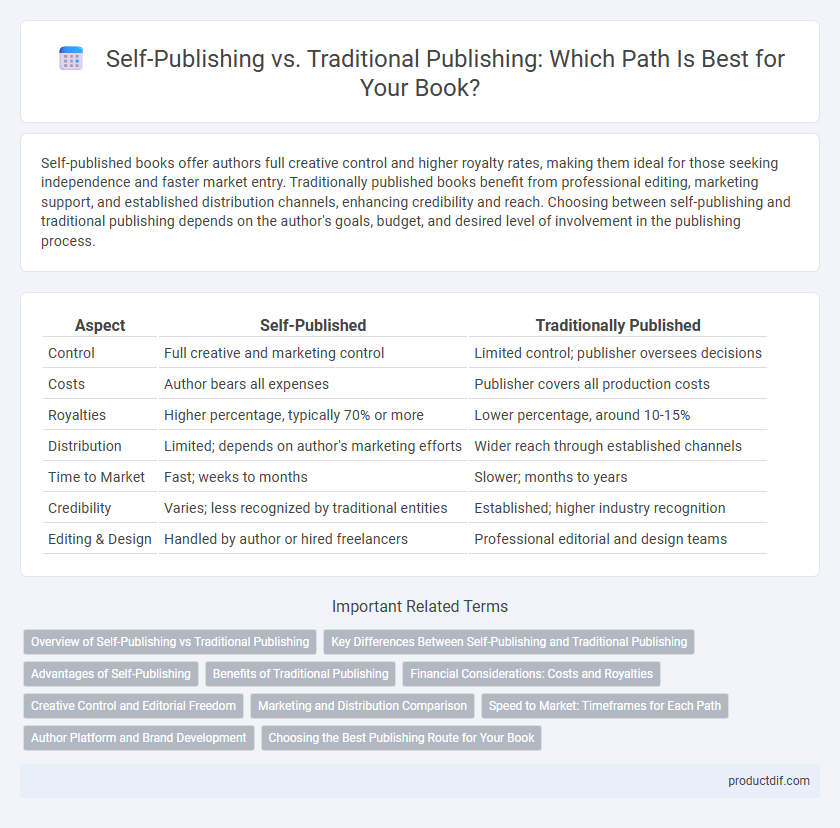Self-published books offer authors full creative control and higher royalty rates, making them ideal for those seeking independence and faster market entry. Traditionally published books benefit from professional editing, marketing support, and established distribution channels, enhancing credibility and reach. Choosing between self-publishing and traditional publishing depends on the author's goals, budget, and desired level of involvement in the publishing process.
Table of Comparison
| Aspect | Self-Published | Traditionally Published |
|---|---|---|
| Control | Full creative and marketing control | Limited control; publisher oversees decisions |
| Costs | Author bears all expenses | Publisher covers all production costs |
| Royalties | Higher percentage, typically 70% or more | Lower percentage, around 10-15% |
| Distribution | Limited; depends on author's marketing efforts | Wider reach through established channels |
| Time to Market | Fast; weeks to months | Slower; months to years |
| Credibility | Varies; less recognized by traditional entities | Established; higher industry recognition |
| Editing & Design | Handled by author or hired freelancers | Professional editorial and design teams |
Overview of Self-Publishing vs Traditional Publishing
Self-publishing allows authors full creative control and higher royalty rates, bypassing traditional gatekeepers like literary agents and publishers. Traditional publishing offers professional editing, marketing, and distribution through established channels, but involves longer timelines and lower royalty percentages. Understanding the trade-offs between autonomy and support is crucial for authors deciding their publishing path.
Key Differences Between Self-Publishing and Traditional Publishing
Self-publishing offers authors complete creative control and higher royalty rates, typically ranging from 40% to 70%, while traditional publishing provides professional editing, marketing support, and advances but with lower royalties, usually between 10% and 15%. Traditional publishing requires a literary agent and acceptance by publishing houses, whereas self-publishing allows authors to bypass gatekeepers and publish independently via platforms like Amazon Kindle Direct Publishing. The time to market also differs significantly: self-publishing can take weeks, while traditional publishing often spans 12 to 24 months due to manuscript review, editing, and distribution processes.
Advantages of Self-Publishing
Self-publishing offers authors full creative control over content, cover design, and marketing strategies, allowing for rapid publication without the delays of traditional gatekeeping. Higher royalty rates, often between 60-70%, significantly increase an author's potential earnings compared to traditional publishing's typical 10-15% royalties. Self-publishing platforms like Amazon Kindle Direct Publishing and Smashwords provide global distribution and direct reader engagement, fostering niche audience growth and long-term author brand development.
Benefits of Traditional Publishing
Traditional publishing offers authors extensive editorial support, professional marketing strategies, and widespread distribution channels that enhance book visibility and credibility. Established publishers provide access to experienced industry professionals, such as editors, designers, and publicists, ensuring high-quality production and impactful promotion. The traditional route often leads to greater bookstore presence, library inclusion, and media opportunities, which can significantly boost an author's career.
Financial Considerations: Costs and Royalties
Self-published authors typically incur upfront costs such as editing, cover design, and marketing, but retain a higher percentage of royalties, often between 35% to 70% per sale. Traditionally published authors generally avoid initial expenses, as publishers cover production and distribution, but receive lower royalty rates, usually around 10% to 15% of retail price. Understanding these financial trade-offs is crucial for authors evaluating potential earnings and investment risks in book publishing.
Creative Control and Editorial Freedom
Self-published authors retain full creative control and editorial freedom, allowing them to shape their manuscript without external limitations or imposed changes. Traditionally published authors often face editorial oversight, resulting in adjustments to content, style, or structure dictated by publishing house standards aimed at marketability. This trade-off highlights the autonomy of self-publishing against the professional guidance and quality assurance provided by traditional publishers.
Marketing and Distribution Comparison
Self-published authors maintain complete control over marketing strategies, enabling targeted campaigns through social media, email lists, and niche communities to reach specific audiences. In contrast, traditionally published books benefit from established distribution channels, including bookstores and libraries, and often receive professional marketing support and media exposure, enhancing visibility. However, self-published works may face challenges with wide distribution but can leverage digital platforms and print-on-demand services to optimize reach and sales.
Speed to Market: Timeframes for Each Path
Self-published books typically reach the market within weeks to a few months, as authors control every step of the process from editing to distribution. Traditional publishing often requires 12 to 18 months due to manuscript acquisition, editing, marketing strategies, and printing schedules. Authors seeking rapid release may prefer self-publishing, while traditional publishing offers longer preparation designed for wide distribution and market positioning.
Author Platform and Brand Development
Building a strong author platform is crucial for both self-published and traditionally published authors, but self-publishing offers greater control over brand development through direct engagement with readers on social media, email newsletters, and personal websites. Traditionally published authors benefit from the publisher's marketing resources and established distribution channels, which can boost visibility but often limit authors' input in branding decisions. Successful author brand development requires consistent content creation, authentic audience interaction, and strategic use of digital tools to expand reach and loyalty.
Choosing the Best Publishing Route for Your Book
Self-published authors retain full creative control and higher royalty rates, making it ideal for those seeking independence and flexibility. Traditional publishing offers professional editing, marketing resources, and wider distribution, which can enhance credibility and reach. Evaluating your goals, budget, and willingness to manage the publishing process is crucial when deciding between self-published and traditionally published routes.
Self-Published vs Traditionally Published Infographic

 productdif.com
productdif.com